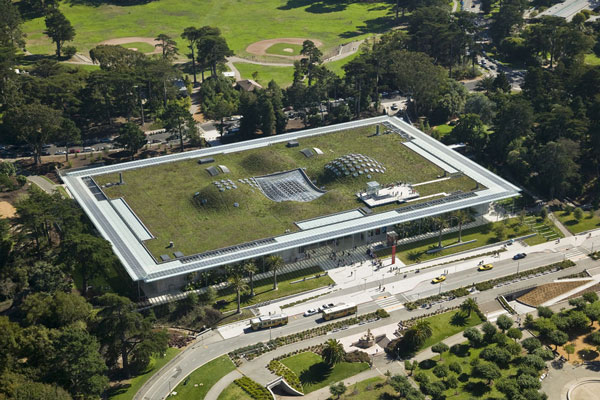Holds the title of most eco-museum in the world, not only because of the saving of natural resources but also achieves the overall green design, signed by the renowned Italian architect Renzo Piano. The California Academy of Sciences, based in San Francisco, is a multidisciplinary institution, whose construction took 10 years and cost $ 500 million.
Opened its doors to the public in 2008 and since then 6 million people have visited, not only to admire the
largest artificial reef in the world located in a museum, a planetarium, aquarium and tropical forests, but the building itself .R. Piano, applying the principles of bioclimatic architecture managed to create a building that borne by the least possible environmental, and-above all-it is not energy intensive. The museum operates in full sun for electricity and natural lighting, air flow for cooling and ventilation of the building, while the planted roof playing a crucial role in the insulation and maintain the internal temperature.
For all these elements the Academy of Sciences, of California has received numerous awards and is the only building in the world that has been awarded twice with the platinum certified LEED, given in lead structures regard to the energy and environmental design. "I tried to impress on the manufacturing complexity of the natural world, part of which brings us the museum. The academy always operated at three levels, highlighting its collections, providing knowledge to the public and giving impetus to scientific research. The purpose of this building is to reinforce and make famous the multifaceted activities of the museum, "explains the architect.
Roof that "breathes"
The stunning rooftop with the hills look like a natural extension of the environment and thanks to this innovative construction ensures the heating and air conditioning in the museum. On the roof of 10 acres has been placed a layer of soil 15 cm thick, which planted native plants. This garden acts as natural insulation of the building, reducing nearly 100% heat loss and cooling. Moreover, maintaining the temperature inside the building 10 ° C lower than a conventional roof, thereby resetting the need for air conditioning in summer.
The small hills leading the air currents inside the museum, and the louvres that look like hatches, apart from plenty of natural light that offer automatically open during the hot days to come out the warm air and in combination with special louvers that have been placed on the walls of a building the air recycling is continuous. The green roof, however, not only contributes to the insulation and ventilation of the museum, but also reduces the need for watering, and absorbs about 11 million liters of rainwater annually.


